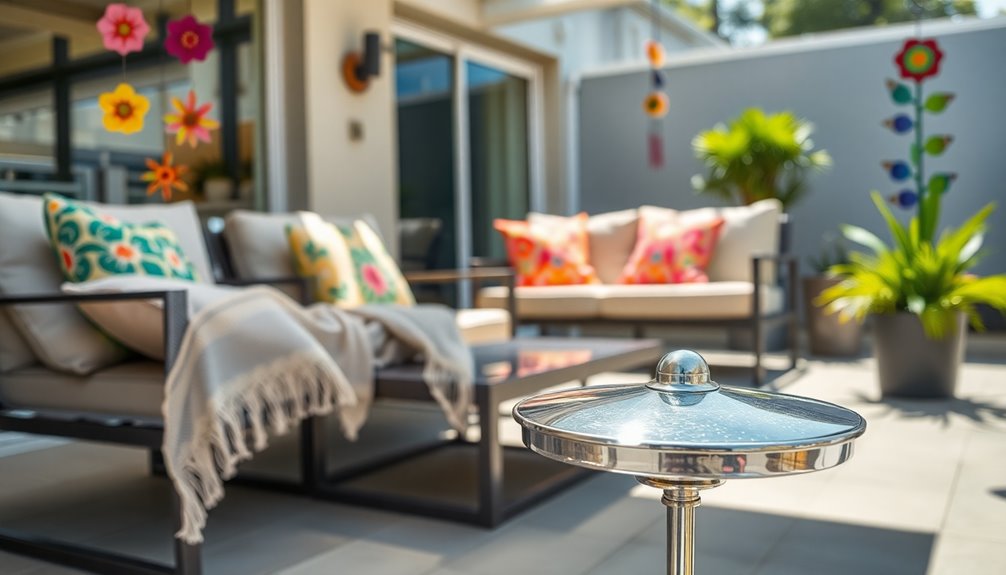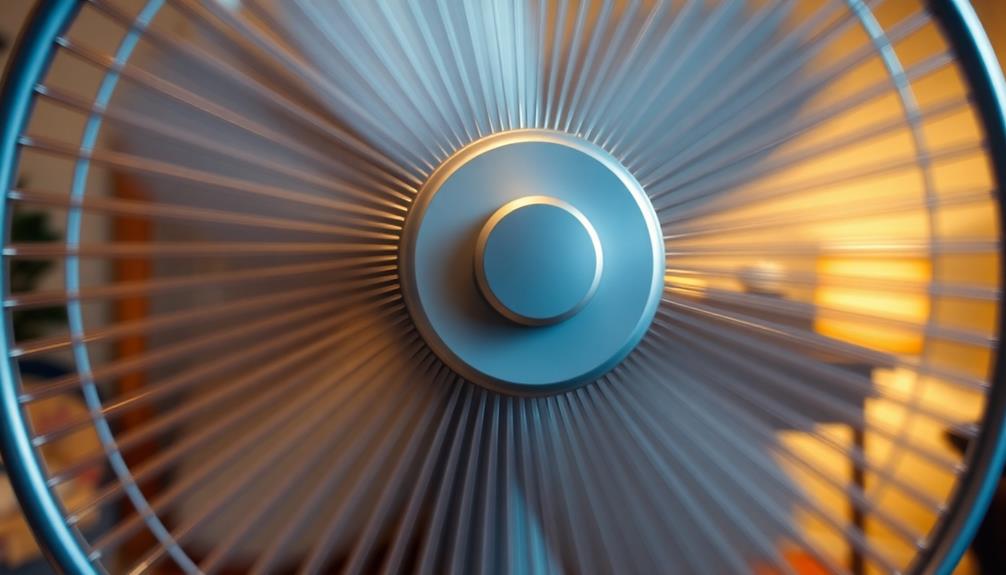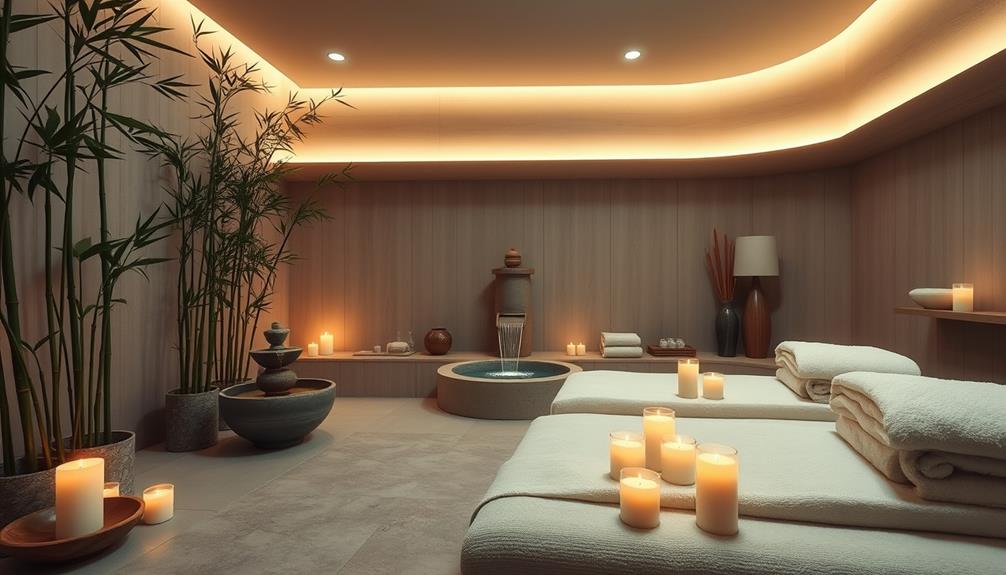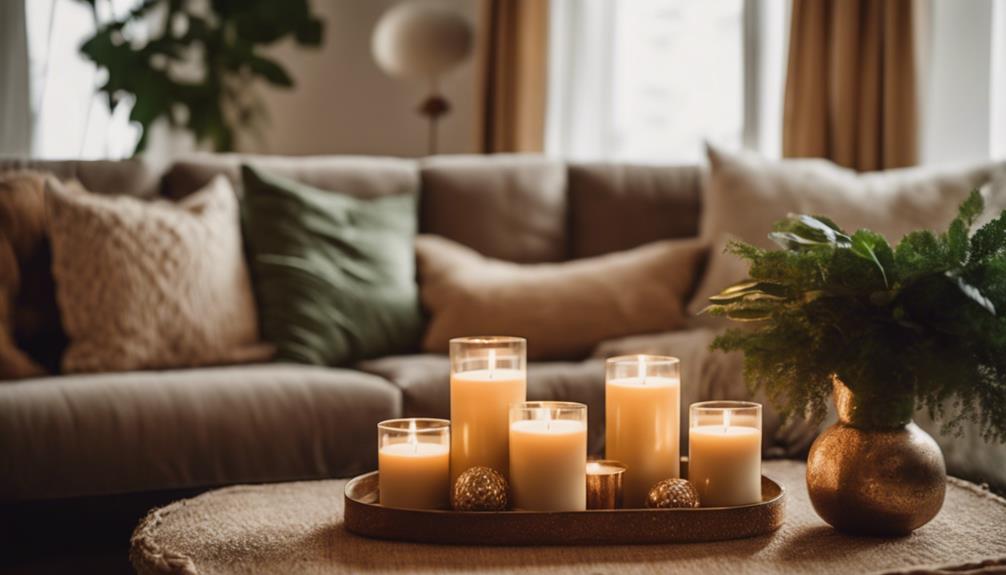To keep birds off your patio furniture, start by eliminating food and water sources nearby. Use lightweight mesh netting or bird spikes to create physical barriers. Hang reflective tape or shiny objects to disturb their vision, and consider placing decoy predators like owls to scare them away. Incorporate sound-based deterrents, like wind chimes or motion-activated devices, to startle birds when they approach. Don't forget to apply citrus-based repellent sprays regularly and maintain a clean space to minimize attraction. With these strategies in place, you'll find your patio furniture stays bird-free, and soon you'll discover even more effective tips!
Key Takeaways
- Use lightweight mesh netting or weatherproof covers to create physical barriers that prevent birds from accessing patio furniture.
- Install bird spikes on flat surfaces to deter birds from perching on furniture.
- Apply citrus-based repellent sprays regularly to create unpleasant scents that birds dislike.
- Utilize reflective materials or decoy predators to create visual disturbances that keep birds away.
- Keep the patio clean by promptly removing food scraps and debris to reduce bird attraction.
Understanding Bird Behavior
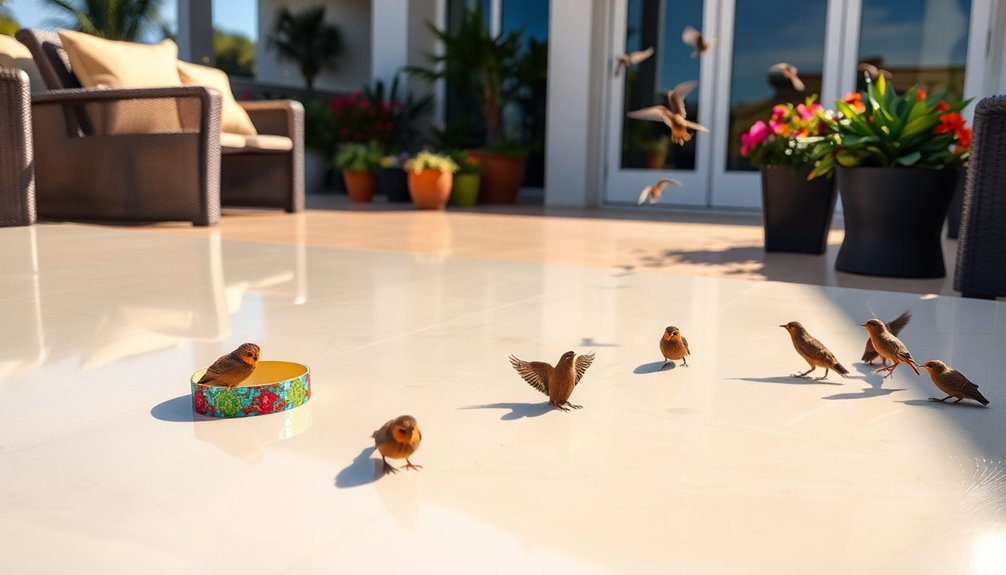
Understanding bird behavior is crucial for keeping them off your patio furniture. Birds are naturally attracted to areas that offer food, water, and shelter. If you've got food scraps or nearby water sources, you're likely inviting these feathered guests to make themselves at home. Reflective surfaces and certain bright colors can further entice them, making your patio a preferred spot for resting or even nesting.
Territorial behavior also plays a role. Birds defend their space through singing and aggressive posturing, which could lead them to frequent your patio. During winter, they might group together for safety while foraging, especially when food is scarce. Understanding how food availability influences their behavior can help you implement effective deterrent strategies.
Physical Barriers for Protection
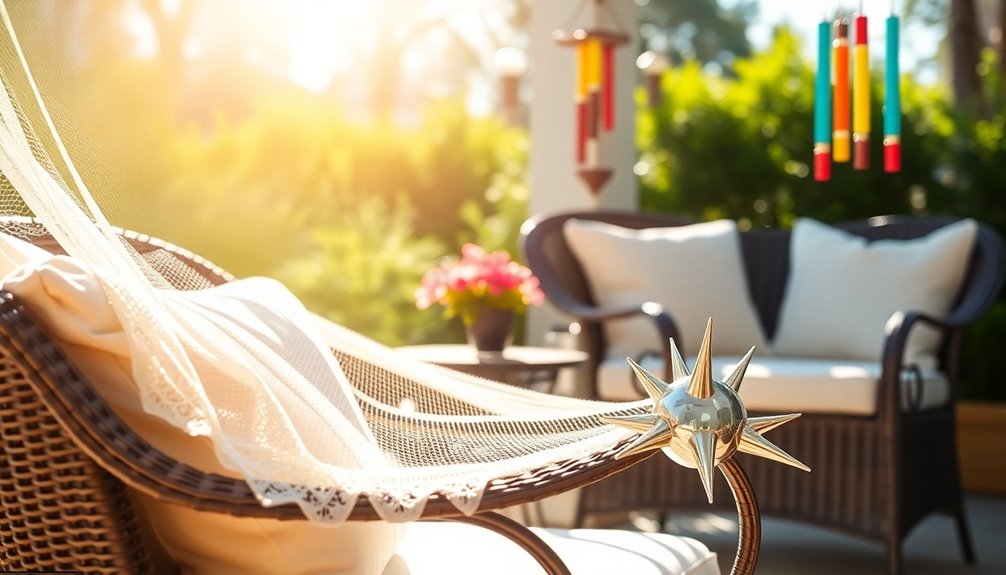
How can you effectively keep birds off your patio furniture? One of the best ways is to use physical barriers. Lightweight mesh netting can create an effective barrier against birds, preventing them from landing, perching, or nesting on your furniture. Make sure the netting is securely fastened and covers the entire area, which also protects your furniture from bird droppings and damage.
Bird spikes are another great option. They make landing on flat surfaces uncomfortable for birds, deterring them from perching or roosting. Strategically install spikes in areas where birds are inclined to land for targeted protection.
You can also create an obstacle course using fishing line or transparent monofilament. Stringing these materials across your patio can effectively deter birds from landing. Additionally, motion-activated sprinklers can startle birds with sudden bursts of water.
Lastly, using tarps or covers to shield your furniture when not in use serves as an effective visual deterrent. It disrupts birds' sense of familiarity and keeps your furniture safe from the elements. Storing furniture indoors or under cover is also a smart move. Incorporating bird spikes alongside these methods can enhance your overall protection strategy.
Effective Visual Deterrents
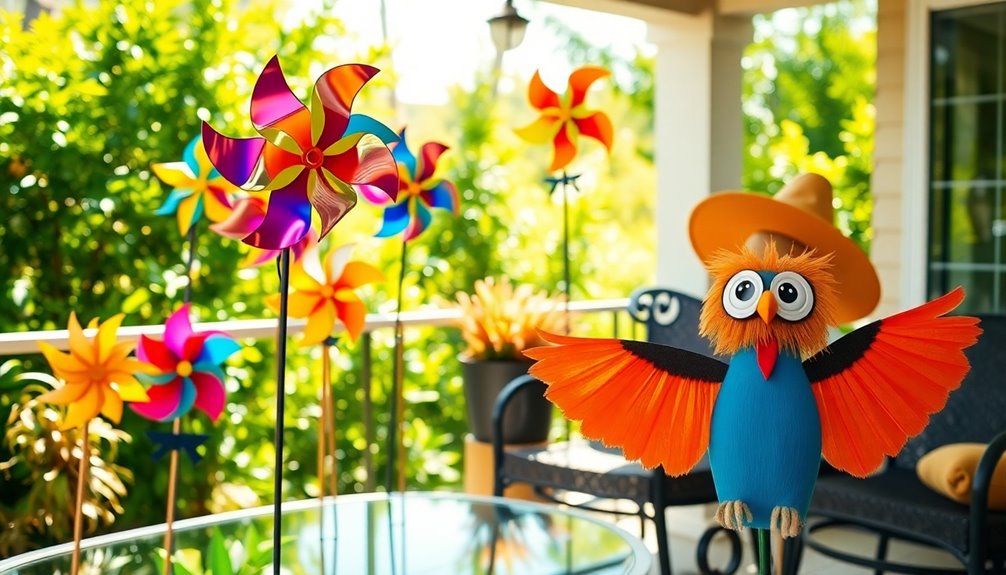
After implementing physical barriers, you can enhance your efforts to keep birds off your patio furniture with effective visual deterrents. Start by using reflective materials like tape or aluminum foil strips around your patio. These create bright, unpredictable reflections that disturb birds and mimic the glint of water or fluttering leaves. You can also hang old CDs to create a play of light that disorients them.
Consider incorporating decoy predators such as owls or hawks. Placing these around your patio can create a sense of threat, discouraging birds from settling nearby. Utilize scare balloons with bright colors and fly-away lasers to add additional layers of intimidation. Additionally, using predator decoys like battery-operated flying models can enhance the effectiveness of your deterrents.
For a more dynamic approach, wind chimes or wind spinners introduce movement that keeps birds on edge. You might also string fishing line across the patio as an obstacle course, making navigation tricky for them.
Finally, explore holographic devices and optical gel that capitalize on birds' sensitivity to light and motion. By combining these various visual deterrents, you'll create an unappealing environment, prompting birds to seek safer locations.
Sound-Based Deterrent Methods
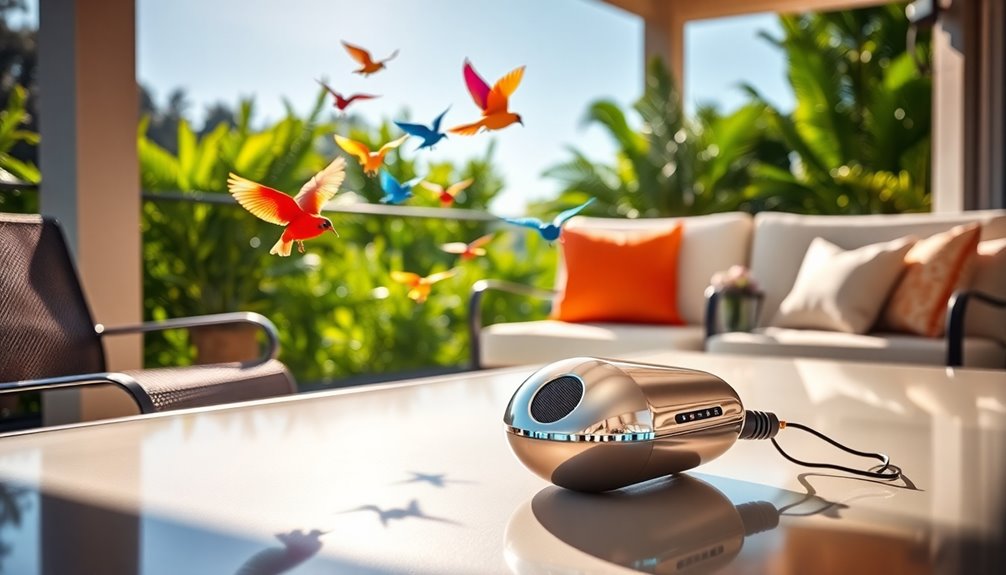
Are you tired of birds making a mess on your patio furniture? Sound-based deterrent methods can help keep those pesky birds away. One effective option is utilizing ultrasonic devices that emit irritating beams, creating a harsh auditory environment that discourages birds from settling in. Place these devices strategically around your patio and adjust the frequency settings to target specific bird species.
Another approach is to employ predator calls or distress sounds. By playing these noises through outdoor speakers, you can simulate the presence of predators, signaling danger to incoming birds. Motion-activated sound devices that startle birds with sudden bursts of noise can also be quite effective.
Wind chimes can serve dual purposes—adding a calming sound for you while deterring birds. Combine them with high-pitched sounds known to irritate birds for enhanced effectiveness. Additionally, eliminating food sources in your outdoor area not only discourages birds but also enhances the impact of these sound-based methods.
Lastly, consider integrating motion-activated sound systems that emit distress signals when birds approach. Make sure to position these devices in areas where birds typically gather, ensuring the sound carries across your patio to maximize coverage. With these sound-based methods, you can enjoy your outdoor space without the mess!
Using Repellent Sprays
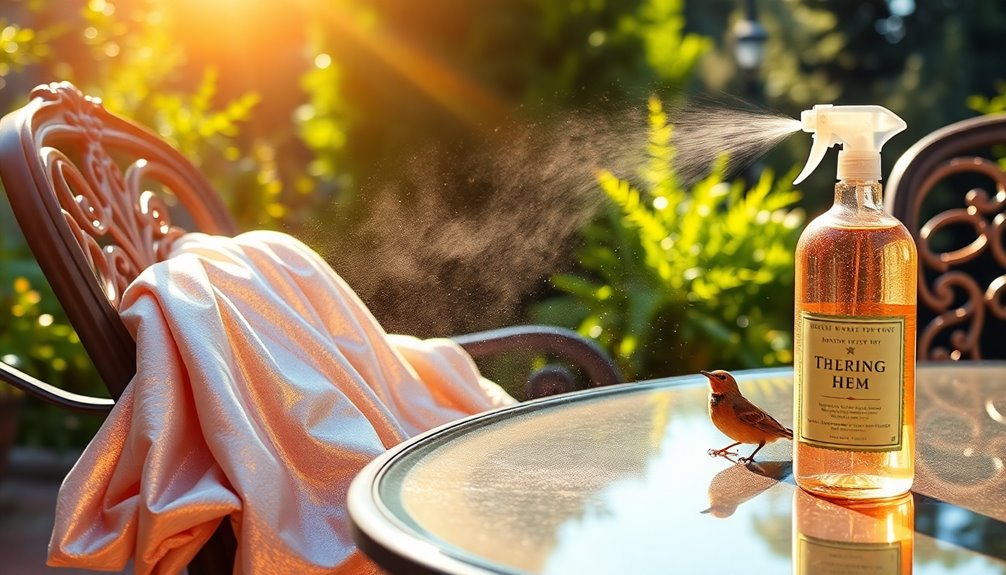
Using repellent sprays can be an effective way to keep birds off your patio furniture. You'll find various types available, including citrus-based sprays that produce scents birds dislike and taste aversion sprays that create an unpleasant sensation. Sticky repellents can also be used, making your furniture undesirable for birds to perch on.
For the best results, apply these repellents consistently and target the areas where birds tend to roost. Always follow the instructions on the packaging regarding reapplication, as this is crucial for maintaining effectiveness. Additionally, consider using citrus-scented products as they are particularly effective in repelling birds. Monitor how well the repellent works and adjust your approach if needed.
Creating Alternative Perching Spots
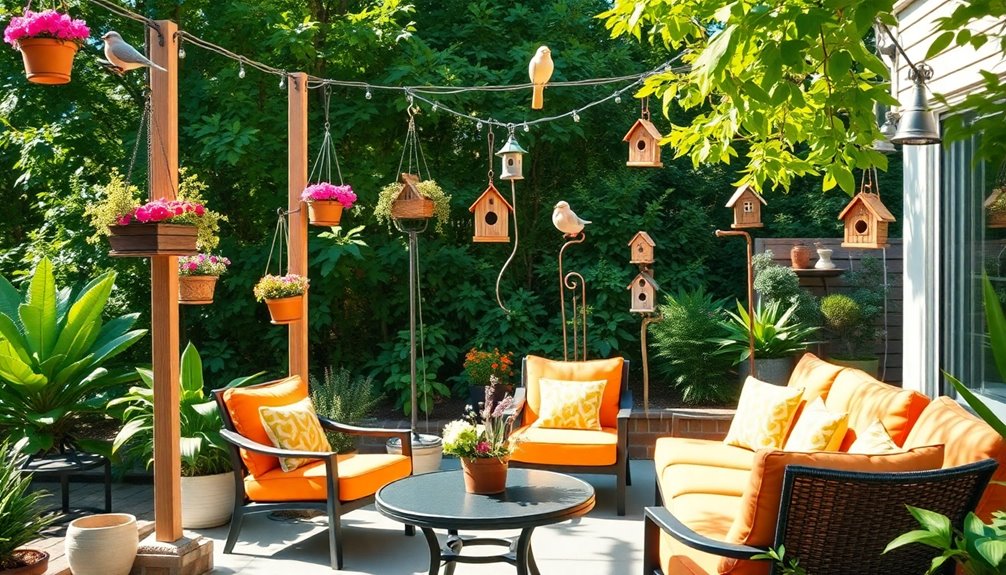
Creating alternative perching spots can significantly reduce the likelihood of birds settling on your patio furniture. Start by installing birdhouses and feeders in a different area of your yard. Position them at a safe distance from your patio, ensuring they're visible but not too close. This way, you can attract birds to these alternative spots while keeping them away from your furniture.
Choose locations that provide natural shelter and food sources, and make sure the flight path to these spots is clear. Using a variety of birdhouses designed for different species, along with bird baths or water features, can enhance the appeal of these areas. Consider incorporating bird-friendly plants and trees to create a welcoming environment. Additionally, removing food and water sources from your patio can further discourage birds from lingering near your furniture.
It's essential to keep these alternative perching spots well-maintained. Regularly clean and refill feeders to keep them attractive. Prune surrounding vegetation to ensure the area remains inviting. By effectively diverting birds to your designated spots, you'll not only protect your patio furniture but also create a thriving habitat for local wildlife.
Importance of Maintenance
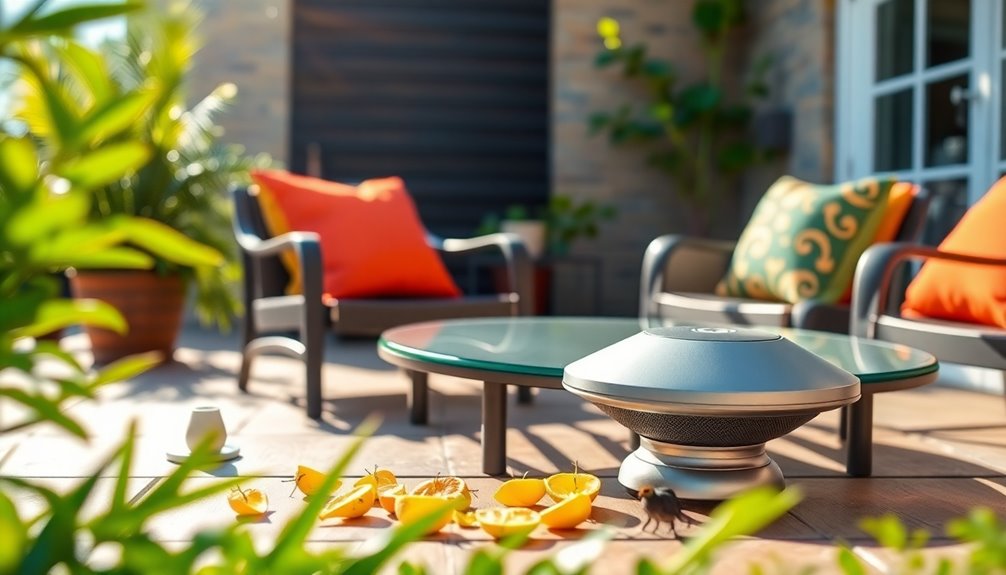
Maintenance is crucial for preserving the longevity and appearance of your patio furniture while keeping birds at bay. Regular cleaning prevents dirt and grime buildup, which can attract birds. By gently but thoroughly cleaning surfaces, you eliminate potential food sources and nesting materials that might invite unwanted guests. Remember to use cleaning methods appropriate for your furniture materials to avoid damage.
Applying protective coatings and sealants shields your furniture from harsh weather conditions, helping to extend its life. Weatherproof covers create a barrier, deterring birds while maintaining your furniture's integrity. Seasonal maintenance is essential; applying protective treatments in spring prepares your furniture for summer elements, while thorough fall cleaning removes debris that could cause damage. Additionally, using high-quality materials for your furniture ensures durability and resistance against environmental factors that could attract birds.
Regular inspections are also vital. They help you identify any wear or damage early on, allowing you to address issues before they escalate. Using physical deterrents, like bird spikes or reflective tape, can further discourage birds from perching on your furniture. By committing to these maintenance practices, you not only enhance the aesthetic appeal of your patio but also create an environment that's less inviting to birds.
Cleaning Strategies for Patios
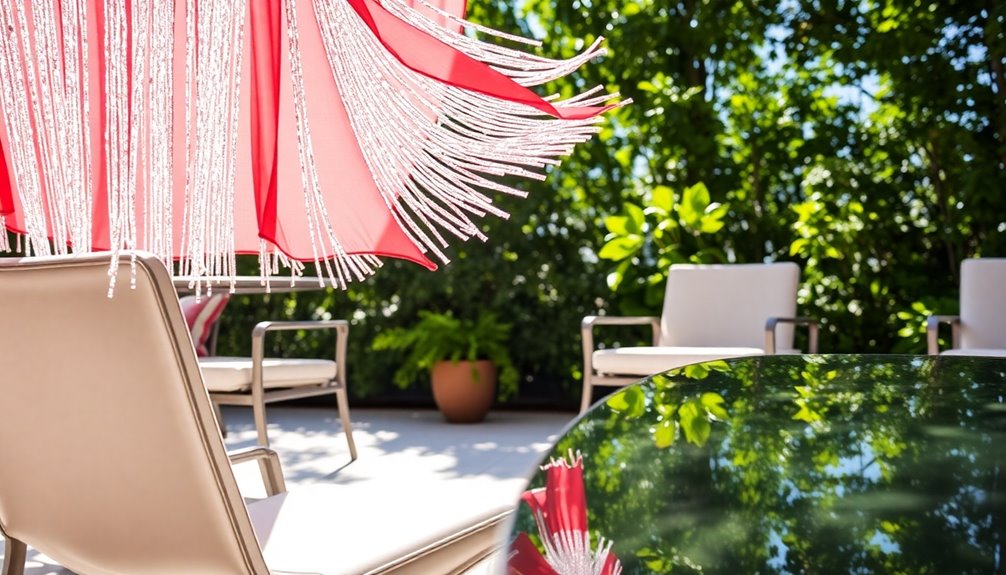
Keeping your patio clean is key to both its appearance and functionality, especially when it comes to deterring birds. Start by removing coarse dirt and debris with a broom or sweeper. This prevents dirt from spreading during your cleaning process. For deeper cleaning, use a pressure washer, adjusting the pressure based on your surface material—high for concrete and low for softer stones.
For environmentally friendly options, try vinegar or bicarbonate soda solutions. Scrub the surface and rinse thoroughly. An electric patio cleaner with rotating brushes can also provide a thorough clean. When dealing with concrete, use minimal water and biodegradable soap to avoid penetrating the pores.
Next, vacuum or sweep your patio furniture, including cushions and pillows. Wash them with dish soap and water, rinse with a hose, and let them dry in the sun. Spray furniture with a hose-attached cleaner to remove spider webs and mold. Regularly inspect for bird droppings and clean them promptly to prevent stains. Address spills and crumbs immediately to keep birds at bay and maintain a clean, inviting patio space. Additionally, regular cleaning helps maintain the appearance and longevity of fabrics on your patio furniture. If you notice any stubborn stains or marks on your patio furniture, such as ballpoint ink, there are specialized cleaners and stain removers available for specific fabric types. Follow the manufacturer’s instructions for ballpoint ink removal to effectively treat the area without damaging the fabric. Taking the time to clean and maintain your patio furniture regularly will not only enhance its appearance, but also extend its lifespan for continued enjoyment. Additionally, consider using furniture covers or storing cushions indoors during inclement weather to further protect your investment.
Utilizing Motion-Activated Devices
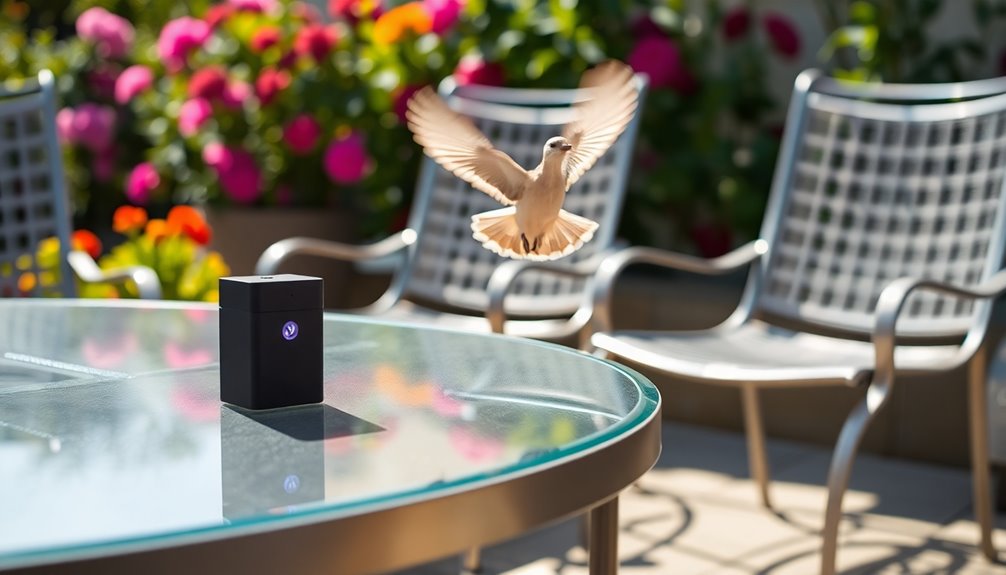
Motion-activated devices can be a game changer for protecting your patio furniture from pesky birds. These innovative tools include motion-activated sprinklers, electronic bird repellers, and ultrasonic devices, all designed to deter birds without causing harm.
Motion-activated sprinklers are particularly effective in small areas like patios and backyards. They detect motion and unleash a burst of water, startling birds and encouraging them to fly away. This automated solution requires minimal maintenance, making it easy to implement. Additionally, the use of physical barriers like netting in conjunction with these devices can enhance overall effectiveness.
Electronic bird repellers work similarly, using motion sensors to detect movement and activate their deterrent mechanisms. They're simple to set up and maintain, perfect for protecting your outdoor spaces.
Ultrasonic devices emit high-frequency sounds that birds find unpleasant, effectively keeping them at bay. Ensure you place these strategically around your furniture for the best results, and opt for weatherproof models to withstand outdoor conditions.
Combining Multiple Strategies
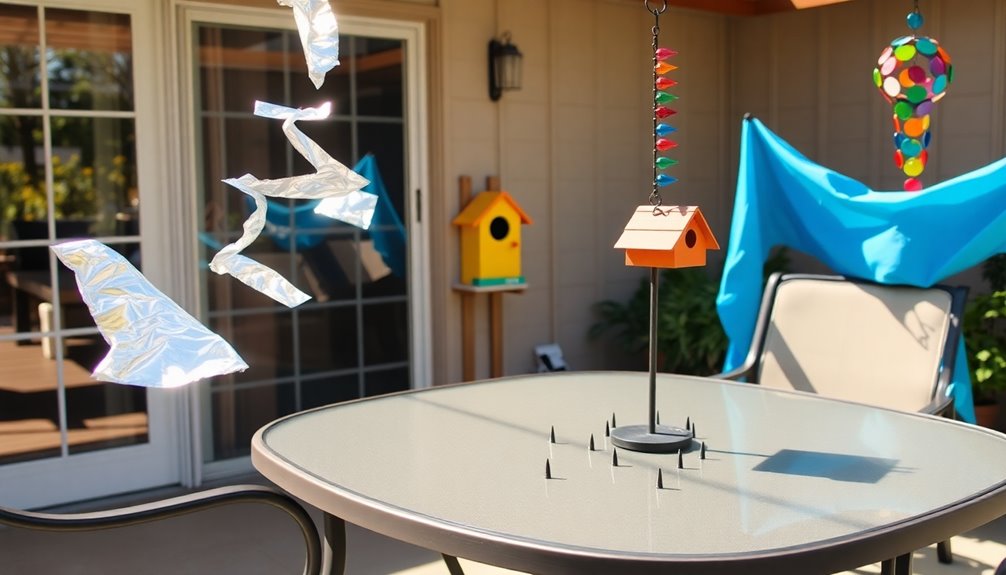
A successful approach to keeping birds off your patio furniture involves combining multiple strategies for maximum effectiveness. Start by installing bird spikes on surfaces where birds tend to perch. This makes it uncomfortable for them to land. Next, apply repellent sprays with citrus fragrances to deter them further. Incorporate shiny, reflective decoys like tape or CDs to create visual disturbances that will keep birds away.
Consider providing alternative perching spots in your yard. Set up birdhouses and feeders in a different area, ensuring they're clean and well-maintained. This can redirect birds' attention away from your patio. Additionally, create a diverse bird-friendly environment with plants and water sources to keep them engaged elsewhere. Keeping outdoor areas clean is essential to minimize attraction for birds, including promptly cleaning crumbs and spills.
Physical barriers like netting or mesh can also be effective. Cover your furniture with these materials to prevent access. Use fishing line or string to create an obstacle course, making it challenging for birds to approach.
Lastly, maintain a clean patio. Regularly sweep to remove crumbs and spilled birdseed, which attract birds. By combining these strategies, you'll significantly reduce the chances of birds nesting or perching on your patio furniture.
Frequently Asked Questions
What Are the Best Materials for Bird Spikes?
When considering the best materials for bird spikes, you'll find stainless steel and polycarbonate to be top choices. Stainless steel offers unmatched durability and longevity, making it ideal for harsh conditions, while polycarbonate is lightweight and cost-effective. If you're dealing with larger bird species, extra-wide spikes provide better coverage. For irregular surfaces, flexible spikes adapt easily. Ultimately, your choice depends on your specific needs and budget, ensuring effective bird deterrence.
How Often Should I Replace Visual Deterrents?
You should replace visual deterrents every few days to keep them effective. Birds can quickly get accustomed to stationary objects, so rotating their placement helps maintain their effectiveness. Change the arrangement and types of deterrents regularly, ensuring they're positioned close to landing areas. Check for wear and tear, and replace any damaged items promptly. Keeping your deterrents dynamic will help you stay ahead of those pesky birds!
Can Birds Become Accustomed to Sound Deterrents?
Yes, birds can become accustomed to sound deterrents over time. If the sounds remain consistent, they may ignore them, thinking there's no danger. To prevent this, you should regularly change the types and frequencies of sounds you use. Rotating different sound devices and adjusting their placement can keep birds on edge, making them less likely to habituate. By creating an unpredictable auditory environment, you'll enhance your chances of keeping them away effectively.
Are There Specific Scents That Attract Birds?
Yes, there are specific scents that attract birds. You'll find that many birds are drawn to food-related smells like fish oils and bacon fat. Some species, like Dark-eyed Juncos, respond to the odors from their preen oil, which they use for mating signals. Additionally, floral scents can attract birds for pollination purposes. Understanding these scents can help you appreciate bird behavior and their interactions with their environment.
How Far Should Alternative Perching Spots Be From Furniture?
To effectively divert birds, you should place alternative perching spots at least 10-15 feet away from your furniture. This distance helps redirect their attention, making it less likely for them to venture onto your patio. Consider the types of birds in your area and the layout of your yard, as these factors can influence how far you need to position these spots for optimal results. Visibility is key, so choose open areas for placement.
Conclusion
By combining various strategies, you can effectively keep birds off your patio furniture. Use physical barriers, visual deterrents, and sound-based methods to create an unwelcoming environment for them. Don't forget to maintain your space and clean regularly to eliminate any attractive spots. Motion-activated devices can also add an extra layer of protection. With a little effort and creativity, you'll enjoy a bird-free patio that's perfect for relaxation and entertaining!
